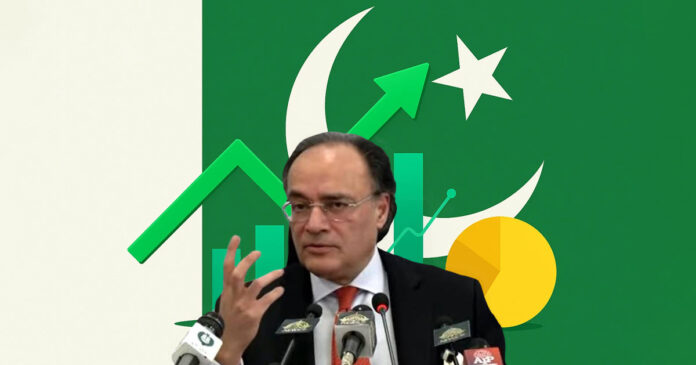Federal Finance Minister Muhammad Aurangzeb, while presenting the Economic Survey 2024–25 on Monday, announced that the country’s GDP grew by 2.7% and inflation dropped to 4.6% during the outgoing fiscal year.
The Economic Survey 2024–25 comes just a day before the federal budget for the next fiscal year is to be tabled in the National Assembly.
The economic survey highlights the country’s overall socio-economic performance in FY2024–25. It includes data related to GDP growth, tax revenue, public debt, employment, climate change, inflation, trade, population growth and balance of payments.
According to the finance minister, “This document aims to guide policy planning and inform public discussions ahead of the new fiscal year.”
Key Indicators
Aurangzeb mentioned a major reduction in the policy rate from 22% to 11%, describing it as a “record cut.” He noted record recoveries in the power sector due to ongoing reforms.
The finance minister shared that Pakistan’s exports rose by 7% while IT exports reached $2.8 billion, with freelancers earning $400 million.
He added that imports increased by 11.7%, yet the current account showed a surplus of $1.9 billion from July to April, mainly due to a 26% increase in revenue collection.
Aurangzeb said, “Remittances increased by around $10 billion in two years,” calling it a significant contribution to foreign exchange.
He further shared that the number of individual tax filers doubled, calling it a positive result of the government’s tax net expansion.
Speaking on economic recovery, he said, “Islamabad has recovered in terms of GDP growth compared to global growth.”
He also noted that global inflation dropped from 6.8% to 0.3%, while Pakistan’s foreign exchange reserves improved significantly.
“We now have to move towards GDP stabilisation,” he added, stating that the country is moving in a “better direction.”
He projected that Pakistan’s GDP will grow by 5.7% over the medium term.
Revenue and Remittances
The survey noted that total revenue grew by 36.7% to Rs13,367 billion between July and March.
Tax revenue rose by 26.3% to Rs9,300.2 billion, while non-tax revenue increased by 68% to Rs4,229.7 billion. FBR matched the overall tax collection figure at Rs9,300.2 billion.
The fiscal deficit narrowed to 2.6% of GDP, and the primary balance showed a surplus of Rs3,468.7 billion, equivalent to 3.0% of GDP.
From July 2024 to April 2025, remittances totaled $31.2 billion, marking a 31% year-on-year rise from $23.8 billion in FY2024.
Aurangzeb said this “was instrumental in supporting the $1.9 billion current account surplus.”
Inflation
On the monetary front, CPI inflation averaged 4.7% during July–April FY2025, with April 2025 inflation dipping to 0.3%, marking a multi-decade low.
While core inflation figures were not explicitly stated, the State Bank of Pakistan reduced the policy rate by 1,100 basis points since June 2024 in response to easing price pressures. The KIBOR also declined to 11.3%.
Agriculture Sector
In FY2025, Pakistan’s agriculture sector recorded a modest growth of 0.56%. Within this sector, important crops declined by 13.49%, while cotton ginning fell by 19.03%.
Moreover, livestock demonstrated strong performance with a 4.72% increase and other crops grew by 4.78%.
Crops which took a hit include maize (-15.4%) and rice (-1.4%). Potato and onion crop yield increased by 11.5% and 15.9%, respectively.
Industrial sector
The industrial sector posted a 4.77% growth in FY2025. However, performance varied across subsectors: mining and quarrying declined by 3.38% and large-scale manufacturing (LSM) contracted by 1.53%.
On the positive side, electricity, gas and water supply surged by 28.88%, while construction registered a growth of 6.61%.
Service Sector
The services sector expanded by 2.91% during FY2025, with mixed trends across its components. Wholesale and retail trade saw minimal growth of 0.14%, while transport and storage improved by 2.20%.
The finance and insurance subsector rose by 3.22%, general government services increased substantially by 9.92%, and other private services grew by 3.64%.
External Sector
In the external sector, exports increased by 6.4% to $26.9 billion, while imports rose by 7.5% to $48.3 billion, resulting in a $21.3 billion trade deficit.
The exchange rate stabilised at Rs278.72 per dollar, and foreign reserves reached $16.64 billion.
Social Protection
For social protection, the government allocated Rs471 billion to the BISP in FY2025.
This included Rs366.9 billion under Benazir Kafaalat for 8.5 million families, Rs55.4 billion under Taleemi Wazaif for 7.96 million children and Rs5.48 billion for 0.7 million mothers and children under Benazir Nashonuma.
Education Spending
The government spent 0.8% of GDP on education from July 2024 to March 2025. Pakistan’s literacy rate stands at 60.6%, with male literacy at 68% and female literacy at 52.8%.
There are 269 universities, including 160 public and 109 private institutions. A total of Rs61.1 billion was allocated for higher education, and PhD faculty members stand at 37.97%.
Stay tuned to Brandsynario for the latest news and updates





































